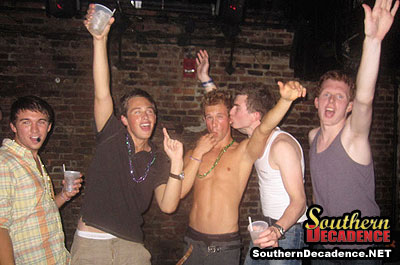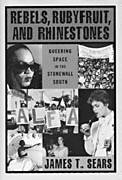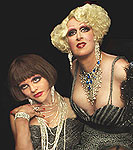|
|

Since it was founded in 1718, New Orleans
has marched to the beat of its own drum. For two
centuries, those in control of the Louisiana state government
have tried in vain to impose their prejudices on a city that
is French, Spanish, Creole, African, Catholic, pagan and very
gay (in both senses of the word). If nothing else, New
Orleans knows how to throw a party, from the world-famous
Mardi Gras to
other, more specialized celebrations.
One of these celebrations began quite inauspiciously in August
of 1972, by a group of friends living in a ramshackle cottage
house at 2110 Barracks Street in the Treme section of New
Orleans, just outside of the French Quarter. It was in
desperate need of repair, and the rent was $100 per month.
At any given
time the residents numbered anywhere from six to
ten,
and it was still sometimes difficult
to come
up with the rent. The large bathroom became a
natural gathering place in the house. It had no shower,
only a clawfoot tub, but it also had a sofa. With from
six to ten residents, and one bathtub, everyone became close
friends. While one soaked in the tub, another would
recline on the couch and read A Streetcar Named Desire
aloud.
The Tennessee Williams play inspired the
residents to fondly name the house "Belle Reve"
in honor of
Blanche DuBois' Mississippi plantation.
 And so
it was, on a sultry August afternoon in 1972, that this band
of friends decided to plan an amusement.
According to author James T. Spears, writing in Rebels,
Rubyfruit and Rhinestones: Queering
Space in the Stonewall South, this "motley crew of outcasts" began
Southern Decadence as a going away party for a friend named
David Randolph, and to
shut up a new "Belle Reve" tenant (from New York) who kept
complaining about the New Orleans heat. As a riff on the
"Belle Reve" theme, the group named the event a "Southern
Decadence Party: Come As Your Favorite Southern Decadent,"
requiring all participants to dress in costume as their
favorite "decadent Southern" character.
According to Spears, "The party began late that Sunday
afternoon, with the expectation that the next day (Labor Day)
would allow for recovery. Forty or fifty people drank, smoked,
and carried on near the big fig tree ... even though Maureen
(the New Yorker) still complained about the heat." And so
it was, on a sultry August afternoon in 1972, that this band
of friends decided to plan an amusement.
According to author James T. Spears, writing in Rebels,
Rubyfruit and Rhinestones: Queering
Space in the Stonewall South, this "motley crew of outcasts" began
Southern Decadence as a going away party for a friend named
David Randolph, and to
shut up a new "Belle Reve" tenant (from New York) who kept
complaining about the New Orleans heat. As a riff on the
"Belle Reve" theme, the group named the event a "Southern
Decadence Party: Come As Your Favorite Southern Decadent,"
requiring all participants to dress in costume as their
favorite "decadent Southern" character.
According to Spears, "The party began late that Sunday
afternoon, with the expectation that the next day (Labor Day)
would allow for recovery. Forty or fifty people drank, smoked,
and carried on near the big fig tree ... even though Maureen
(the New Yorker) still complained about the heat."
The following year the group
decided to throw another Southern Decadence Party. They
met at Matassa's bar in the French Quarter to show off their
costumes, then they walked back to "Belle Reve." This
first "parade" included only about 15 people impersonating
such "decadent Southern" icons as Belle Watling, Mary Ann
Mobley, Tallulah Bankhead, Helen Keller, and New Orleans' own
Ruthie the Duck Lady. This impromptu parade through the
French Quarter and along Esplanade Avenue laid the groundwork
for future events, and the group decided to repeat the
party
again the following year.
 In 1974, the Southern Decadence visionaries
named Frederick Wright as the first Grand
Marshal, hoping to provide at least a modicum of order.
For the next six years,
the format of the celebration changed
little. The founding group continued to appoint each
year's
Grand Marshal by consensus. Some were gay, some
were not.
But all were members of the founding
group. In 1974, the Southern Decadence visionaries
named Frederick Wright as the first Grand
Marshal, hoping to provide at least a modicum of order.
For the next six years,
the format of the celebration changed
little. The founding group continued to appoint each
year's
Grand Marshal by consensus. Some were gay, some
were not.
But all were members of the founding
group.
By 1981, most of the original
organizers had moved on with their lives. Many felt that
the event had become so big that it was no longer the intimate
party they had started nine years earlier. Of the
original group, only Grand Marshal V Robert King was actively participating. He, along with some of his friends that hung out at the Golden
Lantern bar, thought it was worth continuing and they took
over the festivities.
It was at this point that
Southern
Decadence became primarily a gay event. Other protocol
changes made in 1981 included moving the starting point of the
annual parade from Matassa's to the Golden
Lantern bar,
and allowing Grand Marshals to personally name their own
successors. Both of these traditions continue today. And
in 1987, the Grand Marshal began to make a proclamation of the
official
theme, color and song.
Because the 2005 celebration was
cancelled due to Hurricane Katrina, Southern Decadence 2005 Grand
Marshals Lisa Beaumann and Regina Adams reigned for both 2005 and 2006, making
the very first time in Southern Decadence history that grand marshals
ruled for two years. And keeping with the unpredictability of
Decadence, the Grand Marshals from 2008 reigned once again in 2009.
The rest, as they say, is history. What began as
a little costume party is now a world-famous gay celebration.
Now in the 51st year, it has mushroomed from a small gathering of
friends to a Labor Day weekend tradition, attracting over 250,000
participants, predominantly gay and lesbian, and generating over
$275 million in tourist revenue. This annual economic impact
ranks it among the city's top three tourist events.
 Described
by one reporter as "a happening of haberdashery fit for an LSD Alice in
Wonderland," Southern Decadence 2023 will be as outrageous as
ever and live up to its reputation as New Orleans' largest gay
street fair. It all begins in earnest six weeks
before Labor Day. However, the real party starts on the Wednesday before Labor
Day, and the events are non-stop.
It picks up steam daily Described
by one reporter as "a happening of haberdashery fit for an LSD Alice in
Wonderland," Southern Decadence 2023 will be as outrageous as
ever and live up to its reputation as New Orleans' largest gay
street fair. It all begins in earnest six weeks
before Labor Day. However, the real party starts on the Wednesday before Labor
Day, and the events are non-stop.
It picks up steam daily
as it nears Sunday's big street
parade,
which rivals New Orleans'
gay Mardi Gras in scope,
with the party
lasting
well into the day on Monday.

Want to read more about the "Crescent City"?
Click on
the following link:
New Orleans History
Got a
question? Check our
list of Frequently Asked Questions.
Or email us at
info@southerndecadence.net

Southern Decadence web site contents are
Copyright 2023 SouthernDecadence.net
Please read our copyright policy on the Press
and Media page regarding the use of this material.
|